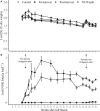Nitrogen Use Efficiency, Allocation, and Remobilization in Apple Trees: Uptake Is Optimized With Pre-harvest N Supply
- PMID: 34135922
- PMCID: PMC8202005
- DOI: 10.3389/fpls.2021.657070
Nitrogen Use Efficiency, Allocation, and Remobilization in Apple Trees: Uptake Is Optimized With Pre-harvest N Supply
Abstract
Optimizing the utilization of applied nitrogen (N) in fruit trees requires N supply that is temporally matched to tree demand. We investigated how the timing of N application affected uptake, allocation, and remobilization within 14-year-old "Gala"/M26 apple trees (Malus domestica Borkh) over two seasons. In the 2017-2018 season, 30 g N tree-1 of 5.5 atom% 15N-calcium nitrate was applied by weekly fertigation in four equal doses, commencing either 4 weeks after full bloom (WAFB) (pre-harvest) or 1-week post-harvest, or fortnightly, divided between pre- and post-harvest (50:50 split). Nitrogen uptake derived from fertilizer (NDF) was monitored by leaf sampling before whole trees were destructively harvested at dormancy of the first season to quantify N uptake and allocation and at fruit harvest of the second season to quantify the remobilization of NDF. The uptake efficiency of applied N fertilizer (NUpE) was significantly higher from pre-harvest (32.0%) than from the other treatments (~17%). The leaf NDF concentration, an indicator of N uptake, increased concomitantly only when pre-harvest N was applied. Pre-harvest treated trees allocated more than half of the NDF into fruit and leaves and stored the same amount of NDF into perennial organs as the post-harvest treatment. Subsequent spring remobilization of NDF was not affected by the timing of N fertigation from the previous season. A seasonal effect of remobilization was observed with a decrease in root N status and a reciprocal increase in branch N status at fruit harvest of season two. These findings represent a shift in the understanding of dynamics of N use in mature deciduous trees and indicate that current fertilizer strategies need to be adjusted from post-harvest to primarily pre-harvest N application to optimize N use efficiency. This approach can provide adequate storage N to support early spring growth the following season with no detriment to fruit quality.
Keywords: 15N; application timing; nitrogen uptake; nitrogen use efficiency; partitioning (nitrogen); remobilization (nitrogen); storage (nitrogen).
Copyright © 2021 Tan, Close, Quin and Swarts.
Conflict of interest statement
The authors declare that the research was conducted in the absence of any commercial or financial relationships that could be construed as a potential conflict of interest.
Figures







References
-
- Aguirre P. B., Al-Hinai Y. K., Roper T. R., Krueger A. R. (2001). Apple tree rootstock and fertilizer application timing affect nitrogen uptake. HortScience 36, 1202–1205. 10.21273/HORTSCI.36.7.1202 - DOI
-
- Benincasa P., Guiducci M., Tei F. (2011). The nitrogen use efficiency: meaning and sources of variation—case studies on three vegetable crops in central Italy. HortTechnology 21, 266–273. 10.21273/HORTTECH.21.3.266 - DOI
-
- Blanpied G. D., Silsby K. J. (1992). Predicting harvest Date Windows for Apples. New York, NY: Cornell Cooperative Extension, 1–12.
-
- Carew R. (2000). A hedonic analysis of apple prices and product quality characteristics in British Columbia. Can. J. Agri. Econ. 48, 241–257. 10.1111/j.1744-7976.2000.tb00278.x - DOI
LinkOut - more resources
Full Text Sources

